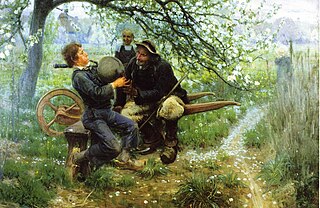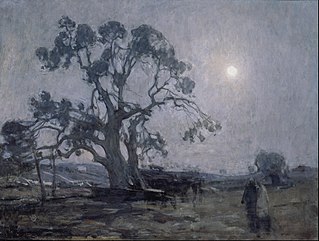
The Nabis were a group of young French artists active in Paris from 1888 until 1900, who played a large part in the transition from Impressionism and academic art to abstract art, symbolism and the other early movements of modernism. The members included Pierre Bonnard, Maurice Denis, Paul Ranson, Édouard Vuillard, Ker-Xavier Roussel, Félix Vallotton, Paul Sérusier and Auguste Cazalis. Most were students at the Académie Julian in Paris in the late 1880s. The artists shared a common admiration for Paul Gauguin and Paul Cézanne and a determination to renew the art of painting, but varied greatly in their individual styles. They believed that a work of art was not a depiction of nature, but a synthesis of metaphors and symbols created by the artist. In 1900, the artists held their final exhibition and went their separate ways.

Thomas Hovenden was an Irish artist and teacher who spent much of his life in the United States. He painted realistic quiet family scenes and narrative subjects and often depicted African Americans.

Maurice Denis was a French painter, decorative artist, and writer. An important figure in the transitional period between impressionism and modern art, he is associated with Les Nabis, symbolism, and later neo-classicism. His theories contributed to the foundations of cubism, fauvism, and abstract art. Following the First World War, he founded the Ateliers d'Art Sacré, decorated the interiors of churches, and worked for a revival of religious art.

Henry Ossawa Tanner was an American artist who spent much of his career in France. He became the first African-American painter to gain international acclaim. Tanner moved to Paris, France, in 1891 to study at the Académie Julian and gained acclaim in French artistic circles. His painting Daniel in the Lions' Den was accepted into the 1896 Salon, the official art exhibition of the Académie des Beaux-Arts in Paris. Tanner's Resurrection of Lazarus was purchased by the French government after winning the third-place medal at the 1897 Salon. In 1923, the French government elected Tanner chevalier of the Legion of Honor.

Pont-Aven School encompasses works of art influenced by the Breton town of Pont-Aven and its surroundings. Originally the term applied to works created in the artists' colony at Pont-Aven, which started to emerge in the 1850s and lasted until the beginning of the 20th century. Many of the artists were inspired by the works of Paul Gauguin, who spent extended periods in the area in the late 1880s and early 1890s. Their work is frequently characterised by the bold use of pure colour and their Symbolist choice of subject matter.

Agostino Brunias was an Italian painter who was primarily active in the West Indies. Born in Rome around 1730, Brunias spent his early career as a painter after graduating from the Accademia di San Luca. After he befriended prominent Scottish architect Robert Adam and accompanied him back to Britain, Brunias left for the British West Indies to continue his career in painting under the tutelage of Sir William Young. Although he was primarily commissioned to paint the various planter families and their plantations in the West Indies, he also painted several scenes featuring free people of colour and cultural life in the West Indies. Brunias spent most of his West Indian career on the island of Dominica, where he would die in 1796. Historians have made disparate assessments of Brunias's works; some praised his subversive depiction of West Indian culture, while others claimed it romanticised the harshness of plantation life. Haitian revolutionary Toussaint Louverture was a prominent admirer of his work.

Self-Portrait with Halo and Snake, also known as Self-Portrait, is an 1889 oil-on-wood painting by French artist Paul Gauguin, which represents his late Brittany period in the fishing village of Le Pouldu in northwestern France. No longer comfortable with Pont-Aven, Gauguin moved on to Le Pouldu with his friend and student Meijer de Haan and a small group of artists. He stayed for several months in the autumn of 1889 and the summer of 1890, where the group spent their time decorating the interior of Marie Henry's inn with every major type of art work. Gauguin painted his Self-Portrait in the dining room with its companion piece, Portrait of Jacob Meyer de Haan (1889).

The Young Sabot Maker is an oil-on-canvas painting made by the American artist Henry Ossawa Tanner in 1895. The painting was accepted for the 1895 Paris Salon and was Tanner's second Salon-entered painting.

The Banjo Lesson is an 1893 oil painting by African-American artist Henry Ossawa Tanner. It depicts two African-Americans in a humble domestic setting: an old black man is teaching a young boy – possibly his grandson – to play the banjo.

The Thankful Poor is an 1894 genre painting by the African-American painter Henry Ossawa Tanner. It depicts two African Americans praying at a table, and shares common themes with Tanner's other paintings from the 1890s including The Banjo Lesson (1893) and The Young Sabot Maker (1895). The work is based on photographs Tanner had taken, and is influenced by his views on education and race, which were in turn derived from those of his father, Benjamin Tucker Tanner, and the African Methodist Episcopal Church. The painting is considered a milestone in African-American art, notably for its countering of racial stereotypes.

The Annunciation is an 1898 painting by the African-American painter Henry Ossawa Tanner. It depicts the biblical scene of the Annunciation, where the archangel Gabriel visits Mary to announce that she will give birth to Jesus. The painting is held by the Philadelphia Museum of Art.

The Bagpipe Lesson is a painting by Henry Ossawa Tanner, completed in late 1893 and displayed at the World's Columbian Exposition and at the Pennsylvania Academy of the Fine Arts 63rd annual exhibition, held from December 18, 1893 to February 24, 1894. The painting was begun by Tanner during his first summer in France, during a trip to Brittany. He finished the work in Philadelphia.

Sarah Elizabeth Tanner was active as a missionary worker and a religious leader in the African Methodist Episcopal Church.

Salomé is a painting by Henry Ossawa Tanner, showing the princess Salome from the Bible, who danced before her stepfather Herod Antipas, and who demanded the head of John the Baptist as a reward for her performance. Tanner painted Salome as part of his Christian-themed paintings.

Abraham's Oak is a painting by Henry Ossawa Tanner, an American painter who lived in France, completed about 1905. While Tanner is well known today for two paintings in the United States, The Banjo Lesson and The Thankful Poor, both about African-American families, the bulk of his artwork, including some of his most iconic paintings, were concerned with exploring biblical subjects. Abraham's Oak was supposed to be a place where Abraham pitched his tent and built an alter to God, who had promised the Land of Canaan for him and his children, and where he was visited by an angel.

Flight into Egypt was a painting by Henry Ossawa Tanner, created in Paris about 1899 and displayed at the Carnegie Institute that year, along with Judas. The painting, a religious work, is an example of Tanner's symbolist paintings. The 1899 version was his first version of the painting.

The Resurrection of Lazarus is a painting by Henry Ossawa Tanner entered into the Paris Salon in 1897 and winning a third place medal. During his lifetime, this was the painting for which he was most known, his "masterwork". Since his death in 1937, secular tastes have pushed The Banjo Lesson to the top place in public esteem. The work was purchased by the French government for display in its Luxemburg museum. Today the painting is held by the Musée d'Orsay.

Christ at the home of Mary and Martha is a painting by Henry Ossawa Tanner completed about 1905 and permanently in the collections of the Carnegie Museum of Art in Pittsburgh, Pennsylvania. Tanner spoke of the painting as having been particularly challenging to paint. The painting was purchased in 1907 by the museum. It was also exhibited in Pittsburgh in 1907 and New York in 1908.

Nicodemus Visiting Christ is a painting by Henry Ossawa Tanner, made in Jerusalem in 1899 during the artist's second visit to what was then Palestine. The painting is biblical, featuring Nicodemus talking privately to Christ in the evening, and is an example of Tanner's nocturnal light paintings, in which the world is shown in night light.

























